Pacific Gas & Electric has selected three new members for the citizen committee working on the decommissioning of California’s sole operating nuclear power plant, the company announced on April 12.
PG&E said it had appointed Michael Lucas, Robert Pavlik and G. Bruce Severance to the Diablo Canyon Decommissioning Engagement Panel and reappointed three members.
“The panel provides community input to PG&E as the company prepares a site-specific plan for the future decommissioning of Diablo Canyon Power Plant and spent fuel management,” the company said in a news release.
Of the three new members, Lucas’ name should ring familiar to Estero Bay News readers. Lucas is a professor emeritus in architecture at Cal Poly, and has taught design since 1997. He also served some 15 years on the Morro Bay Planning Commission.
Lucas has “developed general education electives in design and the built environment for all majors,” the news release said. “His research has focused on the way cultures conceptualize the environment.”
Among his professional accomplishments is serving as “associate dean for academic affairs for the College of Architecture and Environmental Design at the University of Prešov in the Slovak Republic.” Lucas and his family have lived in Morro Bay for over 20 years.
Pavlik is a part-time historian with the California Department of Parks and Recreation, Off-Highway Motor Vehicle Recreation Division, PG&E said.
He was a supervising environmental planner with Caltrans until he retired in 2015, the release said. He also worked for Yosemite National Park Service; served as a member of the City of San Luis Obispo’s Cultural Heritage Committee; served with the Bureau of Land Management’s Carrizo Plain National Monument Advisory Committee, and Heritage Shared. He lives in San Luis Obispo with his wife, Rayena.
Severance “is an electric vehicle and green product designer, licensed green builder, home designer and energy analyst. He is also a climate policy advocate, most recently serving as a regulatory compliance engineer for Mitsubishi Electric, a government relations role in both California and Mexico.”
In recent years, Severance “contributed to the establishment of Cal Poly’s Institute for Climate Leadership and Resilience. Initial projects have focused on repurposing of stranded assets such as the Phillips 66 [refinery] plant in Nipomo.”
He lives in Grover Beach and has been in the South SLO County Area for more than 25 years. The three newbies to the panel will start work in May.
Chuck Anders, PG&E’s panel facilitator said, “The selection committee praises the quality and qualifications of those who applied, and we thank those who have previously served on the Panel, devoting countless, volunteer hours to this important process.”
Created in 2018, the Decommissioning Panel’s task is to “foster open and frequent dialogue between members of the local community and PG&E on matters related to DCPP decommissioning. Panelists are local community members from across San Luis Obispo County who were selected to broadly represent diverse community viewpoints. The Panel meets periodically on matters related to DCPP decommissioning and the future use of DCPP lands and facilities.”
PG&E is committed to closing down Diablo Canyon, the last remaining nuclear plant in California, in 2024 and 2025, when the licenses for the two reactors expire.
It had been on a path to renew the licenses, but abandoned those plans after the State’s commitment to non-fossil fuel burning energy sources that are sustainable and renewable — mainly wind and solar. Also, the State Water Resources Control Board had banned the use of so-called once through cooling systems, i.e. using seawater to cool steam and discharging the heated cooling water into the ocean, which is how Diablo Canyon cools the steam created by a nuclear fission.
Switching the cooling system out at Diablo Canyon proved too costly, especially when coupled with the expense of fighting opposition during what promised to be a contentious Federal re-licensing process.
There have however, been many that have called for Diablo Canyon, which can generate 2.500 megawatts of emissions free power, to remain open until the State replaces what amounts to 10% of the total electrical generation capacity in the entire state.
The decommissioning of the plant is expected to take many years and cost several billion dollars. But the panel’s work focuses on what should be done with the plant property’s 10,000 acres, which include oak woodlands, coastal mountains, Native American sites, and coastal terraces grazed by cattle. It stretches from the eastern edge of Montana de Oro State Park to Avila Beach.


